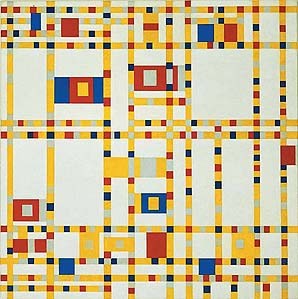Like most artists, Monet used color to evoke atmosphere and emotion in his work. But he used a subtler, although equally powerful, technique to give his paintings depth and, as in this pulsating sun, the illusion of motion. By manipulating luminance (i.e., perceived brightness), artists can create a variety of optical illusions such as twinkling stars, waving grass, or the shadowy descent of a staircase. And although we may respond with feeling to a painting's lush greens or brilliant blues, color plays no role in our abilities to discern movement or three- dimensional shapesboth on canvas and in the world around us.
 |
| In Piet Mondrian's Broadway Boogie Woogie (1942-43), the yellow and gray are close to equiluminant with the off-white background. Therefore, the squares can seem to move or jitter. |
| Piet Mondrian, Broadway Boogie Woogie, 1942-43. Oil on Canvas, 50x50". (73.1943) Given anonymously. The Museum of Modern Art, New York. Photo credit: Digital Image (c) The Museum of Modern Art/Licensed by SCALA. |
In her new book, Vision and Art: The Biology of Seeing (Harry N. Abrams), professor of neurobiology Margaret Livingstonea neurophysiologist whose work on art is a spinoff from her research on the brain's visual systemconnects art and science by showing how canvases cue neurons. She explains, for example, how our visual system processes two integral components of fine art, luminance and color, in two separate parts of the brain that are "as anatomically distinct as vision is from hearing." With examples ranging from early Christian mosaics to Matisse's colorful Femme au Chapeau to Chuck Close's photorealist portraits, Livingstone explores the biological mechanisms that drive our appreciation of great paintings, that make the paintings ultimately work. Frequently, it's got something to do with luminance, which artists refer to as value. "All artists know about value," Livingstone says. "They just don't know about rods and cones."
Most museumgoers probably don't know about value, rods, or cones. It's easy to confuse luminance with the amount of light (i.e., the number of photons) an object or color reflects. However, what we perceive as bright often contains the same number of photons as what we consider dim. Even though each color in a given spectrum reflects an equal number of photons, the yellow and green portions, for example, appear much brighter than the blue and red. This is because our photoreceptors (the cells of our retinas, such as rods and cones, that respond to light) are more sensitive to the wavelengths of yellow and green light than to those of blue and red light. The yellow and green portions are therefore more luminant (but not actually brighter) than the blue and red portions.
When levels of luminance differ across an area or within an object, the brain interprets these differences as signifying three-dimensionality. That is why a simple drawing of a circle, if shaded properly, appears to rise from the page: because shading is the application of luminance gradation. But if the circle is drawn using color gradation (and luminance remains constant), the drawing will lack a sense of depth. In other words, the part of our brain that detects and analyzes luminance contrast, and subsequently alerts us to three-dimensionality, is impervious to color.
Livingstone calls the luminance-responsive part of our visual system the "Where system," since it determines depth, motion, and spatial perceptions. It is also the visual system common to all mammals. "That is why the most basicthat is, the most primitive or necessaryvisual information about a scene is found in luminance variations," she explains. "The parts of our brain that analyze the most basic features of a scene are, quite literally, colorblind." That part of the brain that enables us to see color, as well as recognize objects and faces, Livingstone calls the "What system." (Although certain birds, insects, and fish have independently evolved complex color vision, among mammals only the primates have well-developed color vision.)
Negligible changes in luminance levels can produce dramatic effects, as in Monet's Impression Sunrise. Although our "What system" clearly recognizes the bright orange sun on the muted gray sky, our colorblind "Where system" can't detect the sun at all, because the painted image has the same value, or luminance, as the sky. (In her book, Livingstone reproduces a black-and-white version of the painting that imitates the way our Where system reads the image: the sun is nonexistent in a mostly monochromatic sky.) "The fact that the sun is invisible to the part of the visual system that carries information about position and movement means that its position and motionlessness are poorly defined," Livingstone explains, "so it may seem to vibrate or pulsate."
Although our understanding of the science behind these effects is relatively recent and perhaps incomplete, artists as early as the thirteenth century have parlayed these illusions into powerful and poignant images. Da Vinci, Michelangelo, Ingres, Matisse, and countless others, Livingstone says, used luminance contrasts to enhance their art. "Colors are only symbols," Picasso once explained. "Reality is to be found in lightness alone."
~Catherine Dupree
Margaret Livingstone e-mail address: margaret_livingstone@hms.harvard.edu





